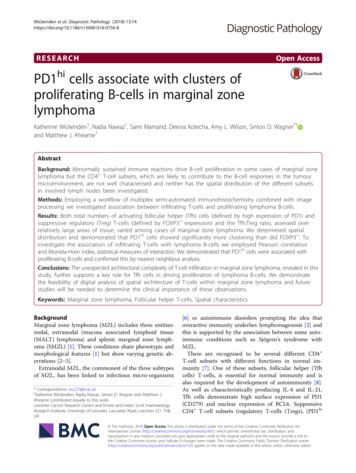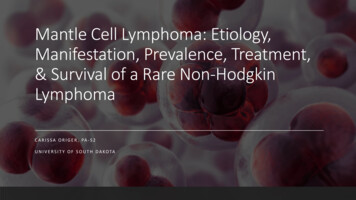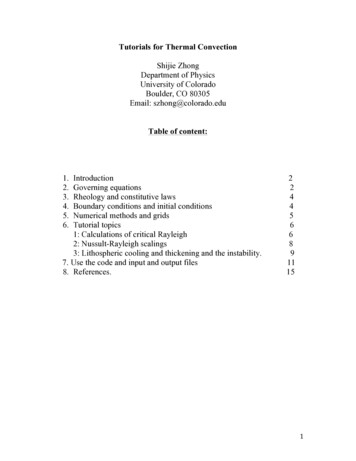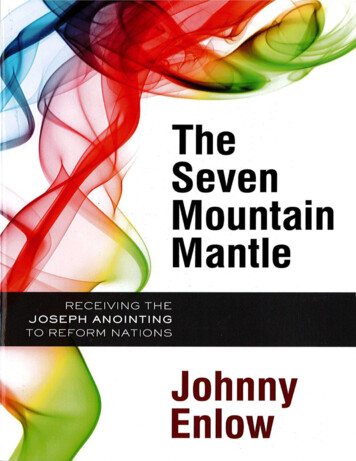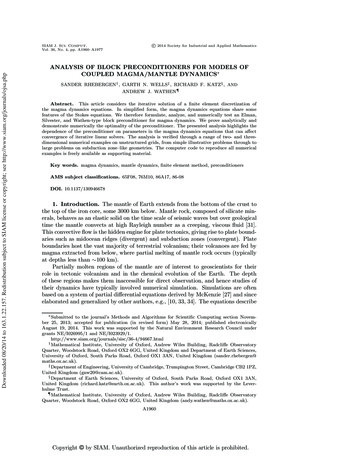
Transcription
Mantle Cell LymphomaUnderstanding Your Treatment OptionsNew Developments in Mantle Cell LymphomaJohn P. Leonard, M.D.Richard T. Silver Distinguished Professor of Hematology and Medical OncologyAssociate Dean for Clinical ResearchVice Chairman, Department of MedicineLymphoma is Complicated Over 60 different types (confusing)––Classifications keep changingMaking an accurate diagnosis is key Different types have different treatments–Vary dramatically Expected goals of therapy can differ widely–––Curing the diseaseLong-term management (“chronic disease”)New ways to understand the disease are continuallyevolving Novel treatments keep coming – CLINICAL TRIALS !!June 26, 20131
Mantle Cell LymphomaUnderstanding Your Treatment OptionsFrequency of NHL Subtypes in AdultsMantle cell (6%)Peripheral T-cell (6%)Follicular lymphoma(22%)Other subtypes with afrequency 2% (9%)Small lymphocyticlymphoma (6%)Compositelymphomas(13%)Marginal zoneB-cell lymphomaMALT type (5%)Diffuse largeB-cell (31%)Marginal zoneB-cell lymphomanodal type (1%)Lymphoplasmacyticlymphoma (1%)Armitage JO and Weisenberger DD. J Clin Oncol. 1998;16:2780–2795.What features determine prognosis? Multiple factors, that interact with each other Type of lymphomaAgeFitness of the patientStageLots of areas of involvement outside of nodes– Depends on type Blood tests Other special tests depending on typeJune 26, 20132
Mantle Cell LymphomaUnderstanding Your Treatment OptionsB-cell non-Hodgkin LymphomaPrognosis and Treatment Indolent (follicular, CLL/SLL, marginal zone) – 30%– Goal: Disease control over many years– Observe, chemotherapy, rituximab (Rituxan ,radioimmunotherapy, combinations, stem cell transplant– Can “transform” to more aggressive type Mantle cell lymphoma – 10%– Goal: Disease control over years– Chemotherapy, rituximab, stem cell transplant, new drugs Aggressive (diffuse large B-cell, Burkitt’s) – 35%– Goal: Curable with chemotherapy rituximab– CHOP-R standard, radiation, other chemotherapy, stem cellMantle Cell Lymphoma (MCL) 5-10% of B-cell NHL 74% male Median age 63 yrs Broad array of treatmentoptions Clinical course can bevariable Characterized by specificgenetic lesions (11;14)Fisher et al, Blood. 1995.Available at: ml.June 26, 20133
Mantle Cell LymphomaUnderstanding Your Treatment OptionsMCL Initial Treatment OptionsObservationR-CHOPModified R-HyperCVADR-CHOP/RITR-BendamustineLess CVAD/MTX/Ara-C/ASCTNordicMore intensiveIf on “watch and wait,” when tostart treatment? Large lymph nodes Many sites Rapid change over time Symptoms Blood count or lab problemsJune 26, 20134
Mantle Cell LymphomaUnderstanding Your Treatment OptionsRituximab Chimeric Anti-CD20Monoclonal Antibody Binds to CD20 receptor on B-cells Administered weekly x 4 infusions Approximately 50% response rate in indolent NHL lastingroughly 12 months– Higher in follicular lymphoma– Lower in SLL/CLL and in aggressive lymphomas– Lower in bulky disease 40% response rate to retreatment Maintenance improves efficacy (? Particularly in MCL) Fc receptor status may correlate with outcome Generally well tolerated Many combinations with chemotherapyRandomized Phase III Study of First-Line B-Rversus CHOP-R in Indolent NHLB-R CD20 FL, SLL,MCL, MZL, LPL Stages III/IV No prior therapy Aged 18 yrsRANDOMIZE15785113141 Days22436485106 DaysCHOP-RFollicular lymphoma: 241Mantle cell lymphoma: 90Small lymphocytic lymphoma: 62Marginal zone lymphoma: 59June 26, 2013291RituximabBendamustineCHOPRummel et. al. ASH 2007, Abstract # 3855
Mantle Cell LymphomaUnderstanding Your Treatment OptionsBendamustine Rituximab vsCHOP Rituximab B-R without hair loss, less blood count toxicity, fewerinfections Response rate about 90%, 50% CR in both Durations of about 2-3 years (ongoing f/u), longer with B-RRummel et. al. ASH 2007, Abstract # 385Issues in Treatment of MCL inOlder or Less Fit PatientsJune 26, 2013 Role for “watch and wait” in asymptomatic patients Bendamustine-Rituximab vs CHOP-R Role of rituximab maintenance Can we use chemotherapy-free regimens? Clinical trial options6
Mantle Cell LymphomaUnderstanding Your Treatment OptionsIssues in Treatment of MCL inYounger or More Fit Patients Role for “watch and wait” in asymptomatic patients Are more intensive treatments better?– Longer remissions, less clear survival Can we use chemotherapy-free regimens? Clinical trial optionsStem Cell Transplantation Autologous stem cell transplant– From “self”, fancy way to give morechemotherapy– More common in MCL, relapsed aggressivelymphoma and relapsed Hodgkin disease Allogeneic stem cell transplant––––From another person – “matched”More toxic, but adds immune anti-tumor effectsLess commonly used in lymphomaNew versions under study – “mini allo” Other new drugsJune 26, 20137
Mantle Cell LymphomaUnderstanding Your Treatment Options2 Opposite MCLManagement Approaches Aggressive strategies– Objective of treatment – long period of remissionextended survival– CHOP-R SCT, hyperCVAD– Hoping that more intensive strategy will pay off– Downside – more toxicity Gentler strategies– Objective of treatment – disease control, less toxicity– Less intensive treatments, new drugs– Hoping that less intensity will improve quality of life– Downside – is it less effective in long term?Biological Effects of Bortezomib (Velcade )Proteasome inhibition has several effects: Affects cell growth regulatoryproteins Interferes with blood vesselformation Directly kills cells Different mechanisms Cancer cells may be moresensitive to effectsJune 26, 20138
Mantle Cell LymphomaUnderstanding Your Treatment OptionsBortezomib (Velcade ) in NHL FDA approved for recurrent MCL Given IV (few min) or SQ d 1, 4, 8, 11 every 3weeks Main side effects: neuropathy, fatigue, platelets Responses in 1/3 of patients, usually 6-12months, some patients longer Also active and under study in other NHL Combinations with rituximab and chemotherapyLenalidomide (Revlimid ) in NHL FDA approved in myeloma, myelodysplasiaand MCL Cousin of thalidomide– Modulates immune system, direct tumor effects,blood vessel formation Pill, given 3 weeks on, 1 off Main side effects are on blood counts, rash,fatigue Responses seen in most lymphoma subtypes– 20-50% of relapsed patients, about 1/3 of MCL pts Several studies in various NHL types Combinations with rituximab andchemotherapyJune 26, 20139
Mantle Cell LymphomaUnderstanding Your Treatment OptionsKey New Drugs in MCL inClinical Trials Ibrutinib (Bruton’s tyrosine kinase inhibitor)– Oral agent, active, well tolerated, numerousongoing studies Idelalisib (PI3 Kinase inhibitor)– Oral agent, active, well tolerated, some ongoingstudies Palbociclib (Cell cycle inhibitor)– Oral agent, some combination studies ABT-199 (Apoptosis inhibitor)– Small MCL experience promisingSo what is a newly diagnosed patient to do .? Make sure the diagnosis is as clear as possible Get educated about lymphoma, clinical trials Develop relationships with a strong care team– MDs, nurses, PA/NP, social work, other support– Expertise, “good fit”, clinical trials access– Family and friends Establish expectations of therapy– Is treatment necessary?– Cure vs long term management, “dictatorship vs negotiation” Chart and carry out plan but be prepared to change it Continue to live your life as best you canJune 26, 201310
Mantle Cell LymphomaUnderstanding Your Treatment OptionsSo what is a patient in remission to do .? Establish expectations about what the disease is likely to do Determine if there are steps to be taken that can reduce the chanceof or delay relapse and whether they are worth the tradeoffs Don’t go crazy worrying about relapse– Generally think hard about doing scans if you are otherwise well Remain educated about what is new in lymphoma Do what you can to support lymphoma research, support andprogress Enjoy being in remission and try to live wellSo what is a patient who has relapsed to do .? Make sure it is truly a relapse before acting Decide if you need to broaden your care team (more complicated) Carefully determine the implications of the relapse– Do you need to act?– What does it mean for my big picture? Review treatment options, pros/cons and expectations– Make sure your list is complete and thoroughly analyzed Consider clinical trials Remember that it is usually not “the end of the world”June 26, 201311
Mantle Cell LymphomaUnderstanding Your Treatment OptionsThe good news Survival is improving in lymphoma (including MCL) Lots of new agents– Enhance standard regimens– Provide less toxic alternatives– Can be useful in relapsed/refractory settings New prognostic tools– Tailor treatment to the patient (slow progress) New insights into biology– Novel potential targets and biomarkers Lymphoma remains an active area of interest forresearchers and pharma/biotechStill room for improvement Too many patients die from or with lymphoma Morbidity from disease and treatment Use of prognostic markers to guide treatment isrudimentary Information remains limited in how best tocombine or sequence agents Patients rarely participate in clinical trials– Phase III trials particularly challenging Decreasing research fundingJune 26, 201312
Mantle Cell LymphomaUnderstanding Your Treatment OptionsConclusions Lots of progress happening – be encouraged Support participation in clinical trials– All I have presented stems directly from patientparticipation in clinical trials– Opportunity for access to new agents andapproachesMantle Cell LymphomaUnderstanding Your Treatment OptionsQuestion and Answer SessionDr. Leonard’s slides are available for download atwww.LLS.org/programsJune 26, 201313
Mantle Cell LymphomaUnderstanding Your Treatment OptionsMantle Cell LymphomaUnderstanding Your Treatment OptionsThe Leukemia & Lymphoma Society’s (LLS) Co-Pay Assistance Program offers financialassistance to qualified MCL patients to help with the treatment-related expenses andinsurance premiums. Patients may apply online or over the phone with a Co-PaySpecialist. WEBSITE: www.LLS.org/copay TOLL-FREE PHONE: (877) LLS-COPAYFor more information about MCL and other LLS programs, please contact an LLSInformation Specialist. TOLL-FREE PHONE: (800) 955-4572 EMAIL: infocenter@LLS.orgJune 26, 201314
June 26, 2013 6 Mantle Cell Lymphoma Understanding Your Treatment Options Bendamustine Rituximab vs CHOP Rituximab B-R without hair loss, less blood count toxicity, fewer infections Response rate about 90%, 50% CR in both Durations of about 2-3 years (ongoing f/u), longer with B-R Rummel et. al. ASH 2007, Abstract # 385

